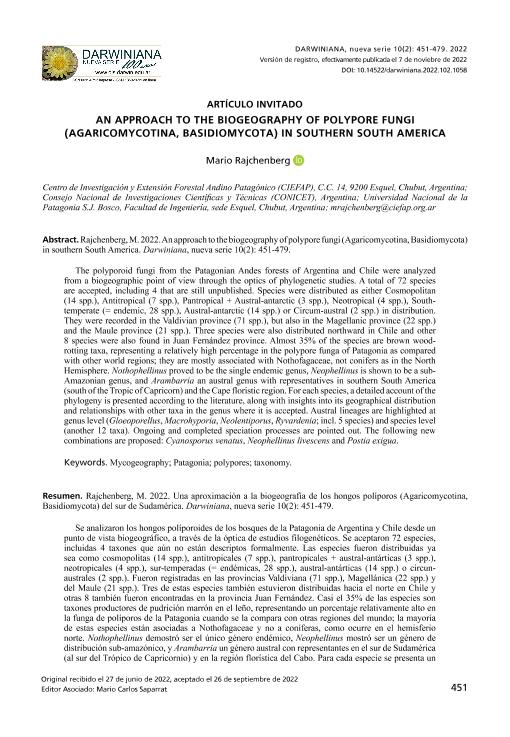Artículo
The polyporoid fungi from the Patagonian Andes forests of Argentina and Chile were analyzed from a biogeographic point of view through the optics of phylogenetic studies. A total of 72 species are accepted, including 4 that are still unpublished. Species were distributed as either Cosmopolitan (14 spp.), Antitropical (7 spp.), Pantropical + Austral-antarctic (3 spp.), Neotropical (4 spp.), South-temperate (= endemic, 28 spp.), Austral-antarctic (14 spp.) or Circum-austral (2 spp.) in distribution. They were recorded in the Valdivian province (71 spp.), but also in the Magellanic province (22 spp.) and the Maule province (21 spp.). Three species were also distributed northward in Chile and other 8 species were also found in Juan Fernández province. Almost 35% of the species are brown wood-rotting taxa, representing a relatively high percentage in the polypore funga of Patagonia as compared with other world regions; they are mostly associated with Nothofagaceae, not conifers as in the North Hemisphere. Nothophellinus proved to be the single endemic genus, Neophellinus is shown to be a sub-Amazonian genus, and Arambarria an austral genus with representatives in southern South America (south of the Tropic of Capricorn) and the Cape floristic region. For each species, a detailed account of the phylogeny is presented according to the literature, along with insights into its geographical distribution and relationships with other taxa in the genus where it is accepted. Austral lineages are highlighted at genus level (Gloeoporellus, Macrohyporia, Neolentiporus, Ryvardenia; incl. 5 species) and species level (another 12 taxa). Ongoing and completed speciation processes are pointed out. The following new combinations are proposed: Cyanosporus venatus, Neophellinus livescens and Postia exigua. Se analizaron los hongos políporoides de los bosques de la Patagonia de Argentina y Chile desde un punto de vista biogeográfico, a través de la óptica de estudios filogenéticos. Se aceptaron 72 especies, incluidas 4 taxones que aún no están descriptos formalmente. Las especies fueron distribuidas ya sea como cosmopolitas (14 spp.), antitropicales (7 spp.), pantropicales + austral-antárticas (3 spp.), neotropicales (4 spp.), sur-temperadas (= endémicas, 28 spp.), austral-antárticas (14 spp.) o circunaustrales (2 spp.). Fueron registradas en las provincias Valdiviana (71 spp.), Magellánica (22 spp.) y del Maule (21 spp.). Tres de estas especies también estuvieron distribuidas hacia el norte en Chile y otras 8 también fueron encontradas en la provincia Juan Fernández. Casi el 35% de las especies son taxones productores de pudrición marrón en el leño, representando un porcentaje relativamente alto en la funga de políporos de la Patagonia cuando se la compara con otras regiones del mundo; la mayoría de estas especies están asociadas a Nothofagaceae y no a coníferas, como ocurre en el hemisferio norte. Nothophellinus demostró ser el único género endémico, Neophellinus mostró ser un género de distribución sub-amazónico, y Arambarria un género austral con representantes en el sur de Sudamérica (al sur del Trópico de Capricornio) y en la región florística del Cabo. Para cada especie se presenta un reporte de su ubicación filogenética sobre bases bibliográficas, con análisis de su distribución geográfica y sus relaciones con otras especies del género donde se la acepta. Los linajes australes se destacan a nivel de género (Gloeoporellus, Macrohyporia, Neolentiporus, Ryvardenia; que incluyen 5 especies) y a nivel de especie (que incluyen otros 12 taxones). Se señalan los casos de especiación en proceso y los completados. Se proponen las siguientes nuevas combinaciones: Cyanosporus venatus, Neophellinus livescens y Postia exigua.
An approach to the biogeography of polypore fungi (Agaricomycotina, Basidiomycota) in southern South America
Título:
Una aproximación a la biogeografía de los hongos políporos (Agaricomycotina, Basidiomycota) del sur de Sudamérica
Fecha de publicación:
12/2022
Editorial:
Instituto de Botánica Darwinion
Revista:
Darwiniana. Nueva serie
ISSN:
0011-6793
Idioma:
Inglés
Tipo de recurso:
Artículo publicado
Clasificación temática:
Resumen
Palabras clave:
MYCOGEOGRAPHY
,
PATAGONIA
,
POLYPORES
,
TAXONOMY
Archivos asociados
Licencia
Identificadores
Colecciones
Articulos(SEDE CENTRAL)
Articulos de SEDE CENTRAL
Articulos de SEDE CENTRAL
Citación
Rajchenberg, Mario; An approach to the biogeography of polypore fungi (Agaricomycotina, Basidiomycota) in southern South America; Instituto de Botánica Darwinion; Darwiniana. Nueva serie; 10; 2; 12-2022; 451-479
Compartir
Altmétricas




